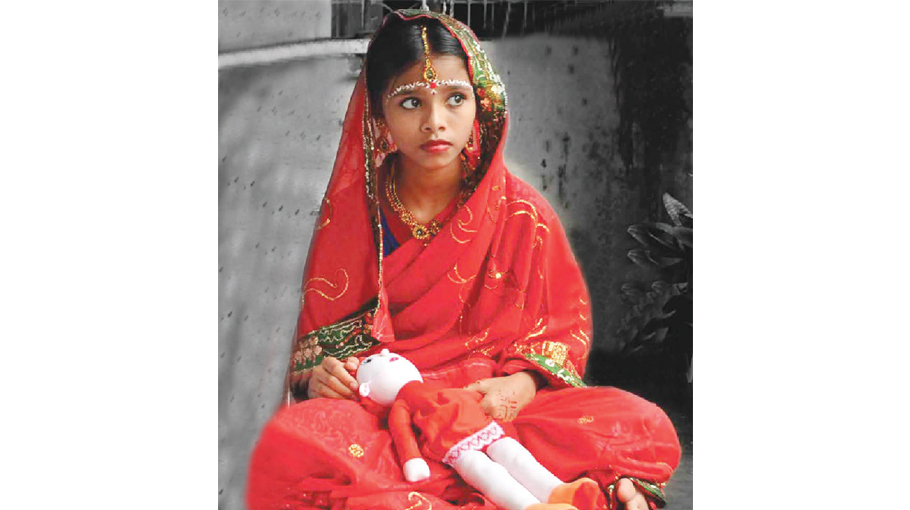Child marriage soaring

A recent survey released by the Bangladesh Bureau of Statistics (BBS) has unveiled a disturbing trend: the incidence of child marriage in Bangladesh is on the rise, particularly among girls under the age of 15.
The report, titled "Bangladesh Sample Vital Statistics 2022," highlights a staggering 50% increase in child marriages within this age group compared to the previous year.
The BBS survey report contained this information. On the organization's website last Wednesday, the final report titled "Bangladesh Sample Vital Statistics 2022" was made available.
Marriage before the age of 18 is a fundamental violation of human rights. Child marriage often compromises a girl’s development by resulting in early pregnancy and social isolation, interrupting her schooling, limiting her opportunities for career and vocational advancement, and placing her at increased risk of violence being perpetrated by her husband. Under the Child Marriage Restraint Act, 2017, the legal age of marriage in Bangladesh is 18 years for a female.
In SVRS (Sample Vital Registration System) 2022, early or child marriage before age 15 increased to 6.46 percent from 4.72 percent in SVRS 2021.
Rajshahi division shows the highest vulnerability, with 11.98 percent of marriages occurring before age 15, followed by Khulna division with 9.38 percent. Sylhet division has the lowest prevalence, with only 1.04 percent.
Early marriage before age 18 rose to 40.85 percent in SVRS 2022 from 32.36 percent in SVRS 2021. Rajshahi division has the highest prevalence, with 52.21 percent occurring before age 18, followed by Barishal division with 49.87 percent. Sylhet Division has the lowest prevalence before age 18, with only 14.86 percent. The increase in early marriages is considered a factor exacerbated by the COVID-19 pandemic.
The BBS survey, a comprehensive study covering 138 demographic indicators, including data relevant to the five-year plan and Sustainable Development Goals (SDGs), involved the participation of approximately thirteen lakh people across 2012 sample areas nationwide.
Bangladesh is a signatory to the UN Convention on Consent to Marriage, Minimum Age for Marriage, and Registration of Marriages. This Convention requires signatory states to obtain consent from both parties entering into a marriage and to establish a legal minimum age for marriage.
A report by the Department of Secondary and Higher Education (DSHE) and the United Nations Population Fund (UNFPA) highlights significant absenteeism among girl students due to early marriage during the pandemic.
Early or child marriage is negatively correlated with household wealth, with higher rates among the poorest quintile and decreasing rates across richer quintiles. Among religions, Muslims have the highest rates (before age 15 at 6.78 percent and before age 18 at 42.20 percent).
Regarding employment, victims of early or child marriage often engage in household chores (before age 15 at 7.71 percent and before age 18 at 48.53 percent). Non-ethnic groups are more vulnerable, although some ethnic groups like Mahali and Manipuri have high rates of early or child marriage, both before and after age 15.
The survey attributes the surge in child marriages to factors such as poverty, a lack of awareness, and the closure of schools during the COVID-19 pandemic. Notably, instances of marriages concealing the brides' ages from the court have become more frequent, further complicating efforts to address the issue.
Alarmingly, even households with relatively higher income levels have witnessed an uptick in child marriage rates. While the average marriage rate for girls under 15 in affluent households stands at 2.90%, it spikes to 24.95% for girls aged 15 to 18. However, child marriage remains more prevalent in economically disadvantaged families, with rates as high as 49.42% among the poorest households.
The survey also reveals a correlation between child marriage and labor force participation, with a significant portion of working girls falling victim to early marriages, especially those engaged in household chores.
An expert emphasizes the adverse socio-economic consequences of child marriage, stressing the importance of raising public awareness alongside legislative measures to curb this alarming trend. He highlights the risks posed to the health and well-being of young brides and calls for concerted efforts to tackle the root causes driving child marriage in Bangladesh.
This problem is concerning, according to Prof. Dr. Mohammad Mainul Islam of Dhaka University's Department of Population Sciences. He stated to Bangladesh Post that this is one of the core issues facing the nation and that it is being gradually increased. He cited data from the Demographic and Health Survey (DHS) 2022 report, which states that 50% of marriages in Bangladesh are child marriages, or one child marriage for every two marriages.
He recommends that verifying each girl's HSC completion should come first. Subsequently, it is imperative to identify high-risk areas, implement preventive measures, raise awareness among families, and extend financial support where feasible. We aim to reduce child marriage to zero, so reaching the SDG goal would be possible. When it comes to child marriage, Bangladesh already stands out among the nations of South Asia.
The surge in child marriage rates underscores the urgent need for comprehensive interventions aimed at protecting the rights and well-being of young girls and ensuring their access to education and opportunities for a better future.




